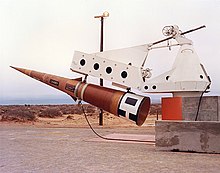| Sprint | |
|---|---|
 Sprint anti-ballistic missile interceptor on a test stand. | |
| Type | Anti-ballistic missile |
| Place of origin | United States |
| Service history | |
| In service | 1975–76 |
| Production history | |
| Manufacturer | Martin Marietta[1] |
| Specifications | |
| Mass | 7,700 pounds (3,500 kg) |
| Length | 26.9 feet (8.20 m) |
| Diameter | 53 inches (1.35 m) |
| Warhead | W66 nuclear low kt |
| Engine |
|
| Propellant | Solid fuel |
Operational range | 25 miles (40 km) |
| Flight ceiling | 19 miles (30 km) |
| Maximum speed | 7,610 miles per hour; 12,300 kilometers per hour; 3,400 meters per second (Mach 10) |
Guidance system | Radio command guidance |
Launch platform | Silo |
The Sprint was a two-stage, solid-fuel anti-ballistic missile (ABM), armed with a W66 enhanced-radiation thermonuclear warhead used by the United States Army during 1975–76. It was designed to intercept incoming reentry vehicles (RV) after they had descended below an altitude of about 60 kilometres (37 mi), where the thickening air stripped away any decoys or radar reflectors and exposed the RV to observation by radar. As the RV would be traveling at about 5 miles per second (8,047 m/s; 26,400 ft/s; Mach 24), Sprint needed to have phenomenal performance to achieve an interception in the few seconds before the RV reached its target.
Sprint accelerated at 100 g, reaching a speed of Mach 10 (12,000 km/h; 7,600 mph) in 5 seconds. Such a high velocity at relatively low altitudes created skin temperatures up to 6,200 °F (3,400 °C), requiring an ablative shield to dissipate the heat.[2][3] The high temperature caused a plasma to form around the missile, requiring extremely powerful radio signals to reach it for guidance. The missile glowed bright white as it flew.
Sprint was the centerpiece of the Nike-X system, which concentrated on placing bases around large cities to intercept Soviet warheads. The cost of such a system quickly became untenable as the Soviets added more ICBMs to their fleet, and Nike-X was abandoned. In its place came the Sentinel program, which used Sprint as a last-ditch defense against RVs that evaded the much longer-ranged LIM-49 Spartan. Sentinel was itself changed to become the Safeguard Program, which was operational only for a few months from October 1975 to early 1976. Congressional opposition[4] and high costs linked to its questionable economics[5] and efficacy against the then emerging MIRV warheads of the Soviet Union, resulted in a very short operational period.
During the early 1970s, some work was carried out on an improved Sprint II, which was mostly concerned with the guidance systems.[6] These were to be dedicated to the task of protecting the Minuteman missile fields. Further work was canceled as US ABM policy changed.
- ^ Cite error: The named reference
NYT_1963was invoked but never defined (see the help page). - ^ Cite error: The named reference
Sprintwas invoked but never defined (see the help page). - ^ Cite error: The named reference
Parschwas invoked but never defined (see the help page). - ^ Cite error: The named reference
Boffey_1969was invoked but never defined (see the help page). - ^ Cite error: The named reference
Finney_1969was invoked but never defined (see the help page). - ^ Cite error: The named reference
Nordman_1977was invoked but never defined (see the help page).